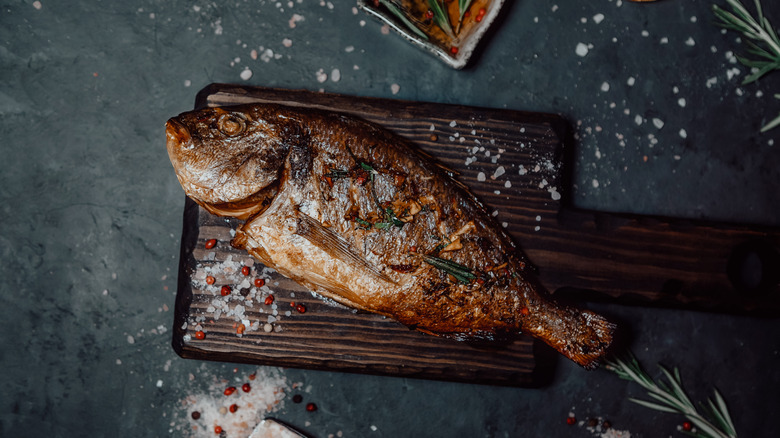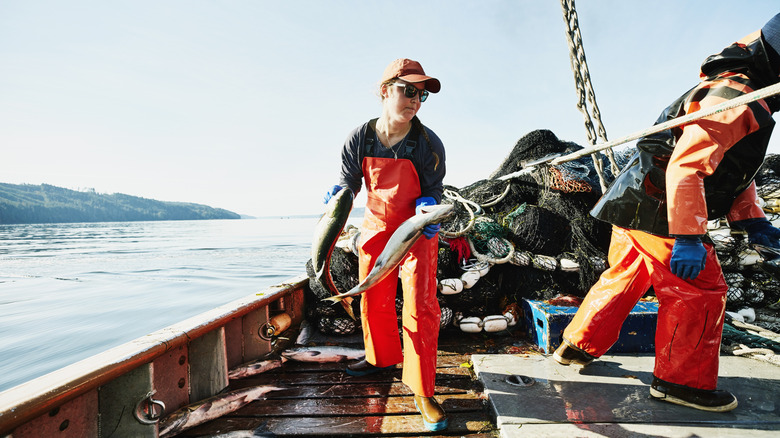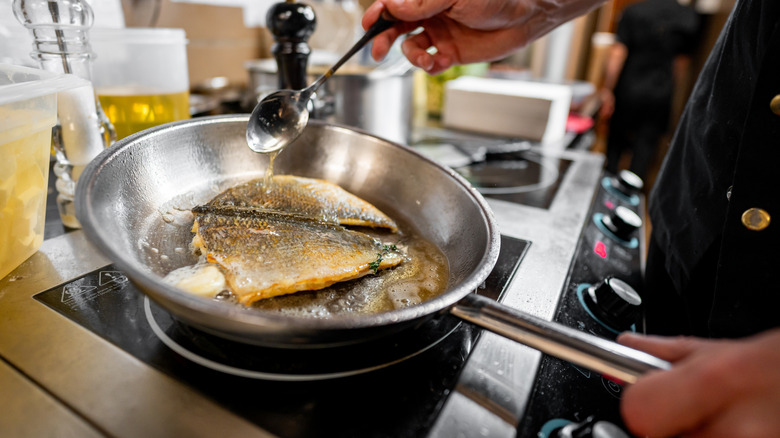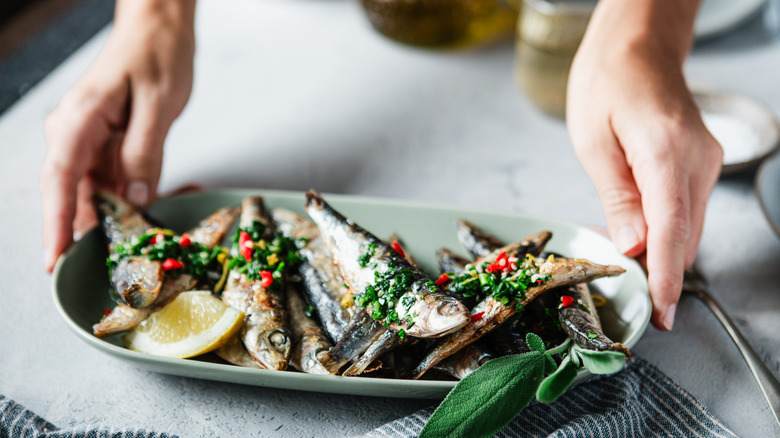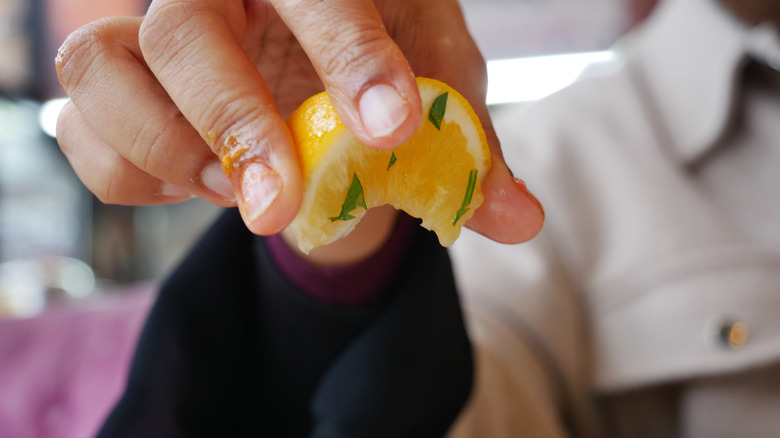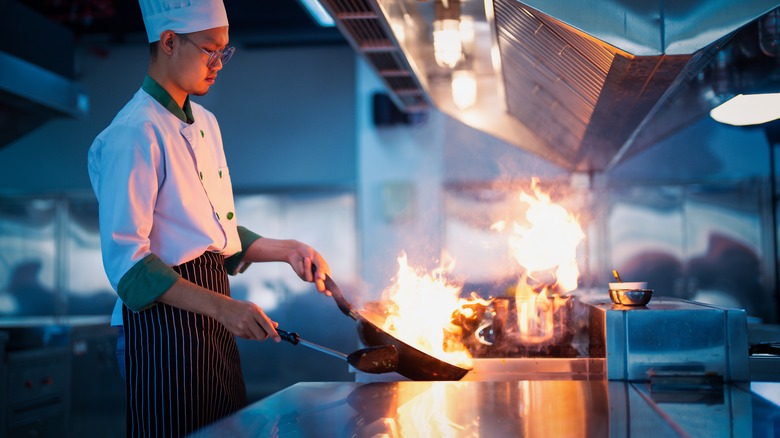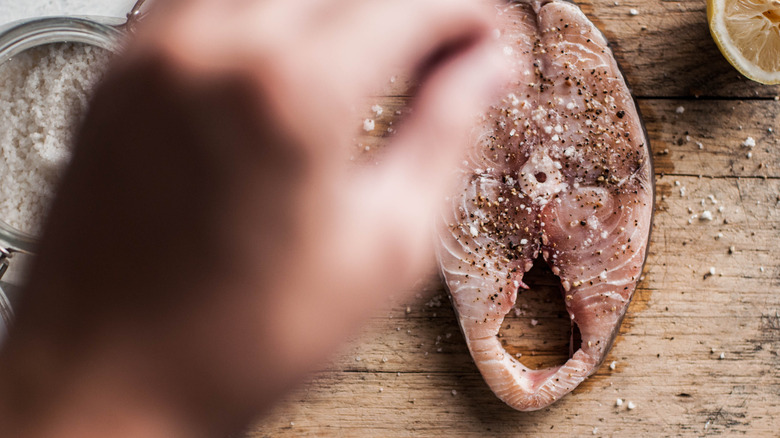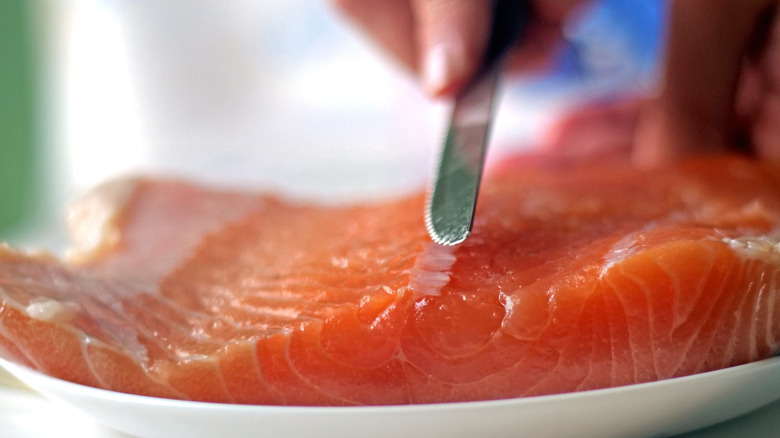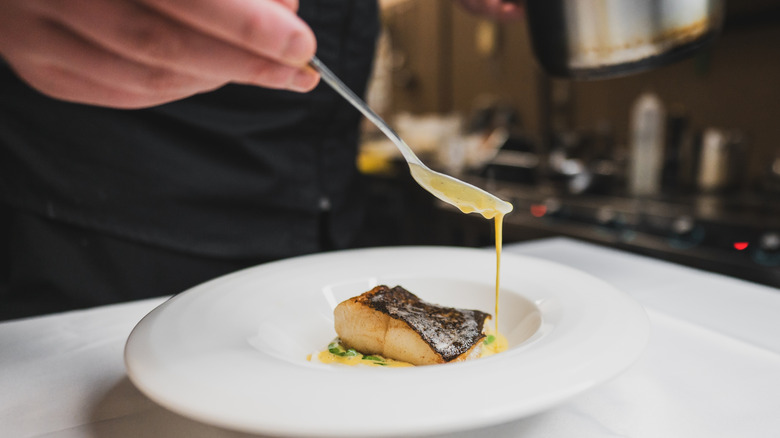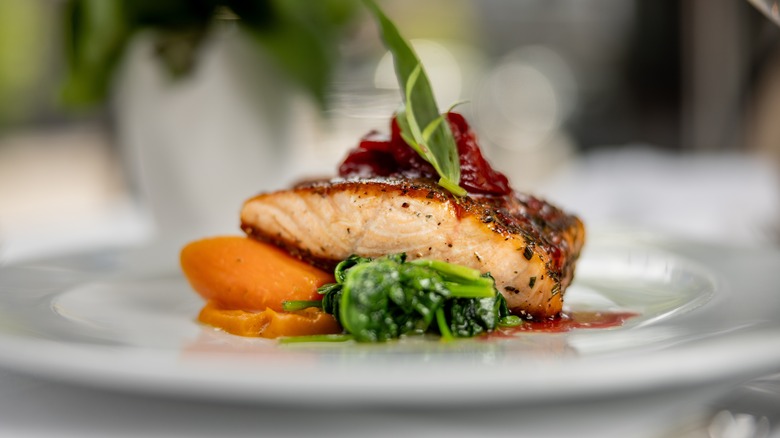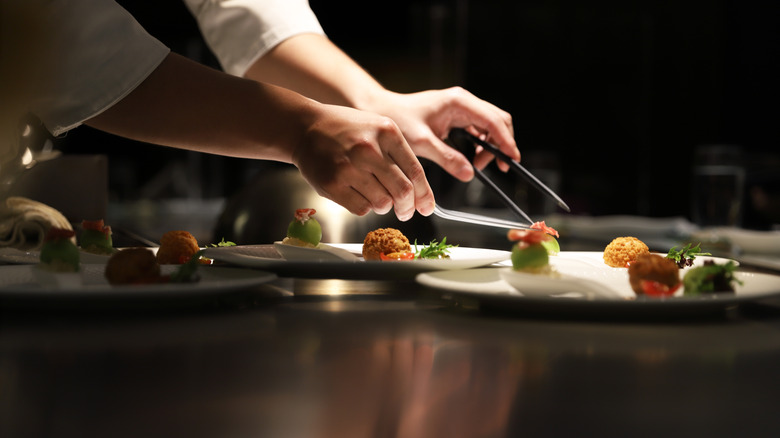Why Restaurant Fish Always Tastes Better Than Homemade
You defrosted your salmon and followed the recipe. Heck, you even squeezed a little lemon on at the end. It's not bad-bad. It's just nothing like the delicious meal you get at your favorite restaurant.
The truth is, your weeknight setup never stood a chance. Restaurant fish wins every time because chefs have a serious edge when it comes to cooking seafood — from sourcing fresher fish to working with hotter pans, sharper instincts, and way more butter than you'd dare to use. They've cooked this dish hundreds (maybe thousands) of times. They know when to flip, when to baste, and when to pull it off the heat before it dries out. They're not folding laundry mid-sauté or Googling "how to tell when fish is done."
But that doesn't mean you can't get close. We're going to break down the pro tips, habits, and techniques that make restaurant fish so much better than what we make at home.
Restaurants have access to better fish
When your go-to fish market is the freezer aisle, it's no wonder restaurant seafood seems to taste better. Many chefs have direct relationships with local fisheries, giving them access to ultra-fresh, sustainably sourced seafood that never sees the inside of a deep-freeze. Local sourcing shortens the distance from dock to dinner plate and preserves natural flavor, texture, and nutrients while supporting the local economy and ecosystem.
Chefs aren't just sourcing better fish; they're also thinking about the bigger picture. According to Restaurant Business, 67% of seafood in the U.S. is consumed at restaurants, meaning chefs have the power to influence our palates and the entire food chain. Some are even turning to species like lionfish and Chesapeake rays to help restore ecological balance and turn ocean threats into delicious entrées, which is why you may often encounter tasty fish dishes in restaurants you'd never think to cook at home.
Crispy fish starts with a pat down
Think of preparing your fish a bit like a TSA screening. Before your fish can board the hot pan, it needs a thorough pat-down. Moisture is the enemy of crisp, and when water sits on the surface of the fish, it ends up steaming, which interrupts the Maillard reaction, the magical chemical process responsible for that golden-brown crust and irresistible umami flavor.
The Maillard reaction only kicks in when heat hits dry protein. If there's moisture in the way, you're left with a pale, limp filet that tastes more poached than pan-fried. Drying the fish with paper towels removes this barrier, allowing heat to do its thing. A dry surface helps seasonings cling instead of slipping and sliding off. Whether you're going simple with salt and pepper or layering on spices, blotting the fish first means your flavors stay where they're supposed to. If you want to take this up a notch, you can also do a dry brine to get the exterior even drier.
They're not afraid of the fishy stuff
While many diners wrinkle their noses at anchovies, sardines, or mackerel, chefs welcome these so-called "fishy" fish with open arms and open menus. These oily varieties pack a punch of umami that elevates dishes far beyond bland filets. They're also often the secret ingredient in sauces, dressings, and spreads that leave you wondering, "Why is this so good?" (If you love Caesar salad but hate anchovies, I have news for you.)
Small fish like anchovies and sardines get a bad rap, despite being eco-friendly, flavor-rich, and central to cuisines around the world. It's not about masking their bold flavor — it's about embracing it. Just like with stinky cheeses or funky beers, once you acquire the taste, it opens up a whole new world of culinary possibilities. While home cooks may shy away, chefs aren't afraid of the funk; they're using it to create some of the most delicious dishes.
They play with acidity
Ever notice how nearly every time you order a seafood dish at a restaurant, it comes with a lemon wedge or a bright, citrusy sauce? It's not just because people in the Middle Ages believed lemon juice could dissolve swallowed fish bones. As marine biologist and lobsterman Curt Brown previously told Chowhound, "The acidity of the lemon makes the sweetness of a lobster pop." The same goes for fish. Citrus brightens flavors and even helps neutralize the compound (trimethylamine) responsible for that fishy smell.
In the right hands, citrus becomes a tool that can help cut through richness, tame fishiness, and light up your palate. At home, we often skip this step or add a bit of lemon as an afterthought. But chefs use acidity throughout the cooking process to give fishy dishes their edge. So, next time you're making salmon, don't forget the splash of lemon, the dash of vinegar, or the acidic punch of a good sauce. It's not just about making the plate look pretty.
Their pans are hotter than yours
One of the most significant differences between restaurant fish and homemade fish is the amount of heat chefs use when cooking their dishes. Professional kitchens use ripping-hot pans that would send most home cooks' smoke alarm blaring. That high heat helps the food cook evenly, creates the perfect sear, and builds a crispy, flavorful skin that's one of the best parts of the dish and good for you.
It's worth noting that restaurants have an extreme advantage in this area. Not only do they have quality pans that can withstand high heat, but they also typically boast powerful burners, industrial hoods, and plenty of airflow to keep smoke (and stress) away. At home, most of us hesitate to crank the heat to high levels or leave fish undisturbed long enough for it to brown beautifully. Add in a fear of lingering fish smells, and it's no wonder that home-cooked fish so often ends up looking pale and a little sad.
They use more salt and fat than you do
Let's be honest, most home cooks are a little shy when it comes to seasoning fish. Maybe you're trying to be healthy, or perhaps you're still haunted by that one time you over-salted salmon and saw your in-laws politely smiling through every bite. Meanwhile, chefs know that salt and fat are essential to unlocking fish's best flavor.
In restaurants, fish isn't just treated to a haphazard sprinkle of salt. Salting fish is a strategic affair. Some fish is best treated with a dry brine, which involves coating it with salt and letting it rest before cooking to improve both texture and taste. And when it comes to fat, chefs use it to bring out textures and flavors you just can't get without it. That seared halibut finished with a lemon-butter sauce or branzino roasted with olive oil brushed on like varnish didn't happen by playing it safe.
The salt wakes up the natural flavor of the fish, while the fat infuses richness, prevents it from drying out, and gives it that silky, restaurant-quality finish. So, if your swordfish steak tastes a little flat, don't blame the fish. It might just need a little more love (and a lot more butter).
Technique makes all the difference
Even with the same fish, salt, and pan, a chef's technique can take a dish from decent to divine. That's because professional kitchens rely on tried-and-true methods that many home cooks may not know. For example, chefs might dry-brine a fillet in advance to boost flavor and lock in moisture. Or they'll lightly score the skin so it stays flat and crisps up evenly. Perhaps they've even mastered cooking fish en papillote, which involves baking fish in parchment paper or foil and maximizes moisture.
In short, the cooks within restaurant kitchens know just how to baste, flip, and rest fish so it doesn't dry out or fall apart. And they've done it all hundreds, if not thousands, of times. These aren't just fancy touches that make chefs look like they're showing off, but small, intentional steps that affect texture, flavor, and visual appeal. Home cooks often skip them out of habit or intimidation, but real chefs know what it's all about. It's the kind of muscle memory that comes from repetition, training, and even the occasional kitchen disaster.
Sauce is their superpower
A perfectly cooked piece of fish is a huge win and something to be proud of, but before you post it to your Instagram, consider the following. To really take it to restaurant level, you need that special sauce — literally. Chefs use sauces to add depth, balance, and richness that's tough to rival with just a simple squeeze of lemon.
The right sauce can highlight a fish's natural sweetness, balance out its richness, or cut through its fattiness for a cleaner finish. Sure, pan-seared halibut with a silky beurre blanc, grilled swordfish with a briny salsa verde, or miso-glazed black cod are beautiful examples, but you don't even have to do all that. Even a simple aioli can transform a crispy fish by adding creaminess and the right hit of flavor.
At home, we often skip this step because we're short on time, intimidated by technique, or simply underestimate how much a sauce can do. But chefs know it's what brings the fish's flavor full circle.
They've cooked this a thousand times
At home, you probably cook yourself a fancy meal when you're trying to impress someone or when you need to make up for "accidentally" binge-watching the next episode without your partner. Meanwhile, the chefs who whip up your favorite fish dishes are used to cooking restaurant-quality meals dozens of times a day. While you're on your seventh Zoom call of the day, they're busy basting, searing, and plating. That kind of repetition builds muscle memory and intuition.
Chefs have developed something close to a sixth sense that tells them when the skin's about to crisp and when the center hits that just-right temp. The rest of us will need to rely on a thermometer. And if you don't have one of those, there's always the metal tool method to check doneness. But if you don't even own a metal utensil (which we hope you do if you're making fish), you can try this easy trick to test fish doneness that takes no special tools.
They plate it like it's a big deal
How your food looks can shape your dining experience well before your fork even hits the plate. That's why chefs don't just slap fish down on a plate and call it a day. They treat every dish like a visual experience by stacking, swirling, drizzling, and garnishing to perfection. A few bright herbs here, some sauce there, and a lemon wedge at just the right angle is not just for the 'gram; it all serves a purpose.
Restaurants understand that we eat with our eyes first and that attention to plating sets a tone. Even if you nail the cook, your at-home salmon served on a paper towel next to some sad broccoli might not taste the same as a similar dish served in an actual professional eatery. So, the next time you cook fish, treat it like the big deal that it is. Your taste buds will thank you.
Chefs aren't distracted by laundry
Cooking fish is a game of seconds. Pull it too early, and it's underdone. Leave it a minute too long, and it dries out. Chefs have the timing down to an art, adjusting heat, flipping at just the right moment, and basting so the flesh stays tender.
Unfortunately for us, we have real-life things to do, and switching between preheating the pan, folding towels, and answering group texts doesn't exactly lead to a perfect sear. Chefs have the advantage of being locked in and not having to worry about toddler meltdowns or last-minute Zoom calls. They're watching that fish like a hawk to see when the edges just turn opaque and listening for when the skin is crisping so they can lift it off the heat at the exact right second.
That single-minded focus is why their fillets arrive at the table silky and flaky instead of dry and sad. To mimic the approach of a professional chef, give the pan your full attention and treat the fish like the only thing on your to-do list.
Ambiance is the secret ingredient
There's a reason restaurant meals seem to hit harder. From the playlist to the plateware, everything is designed to work together and hype up your taste buds. Taste isn't just about your tongue. It's a multisensory experience shaped by sound, smell, sight, texture, temperature, and even your mood. Ambient noise can shape what you taste. So ocean sounds might make seafood feel fresher, while loud, noisy environments can mess with your perception of flavor.
Lighting and temperature also make a difference, with warm spaces boosting your taste sensitivity, while cold, dim rooms do the opposite. Even your mood plays a role. In short, restaurants aren't just cooking your food — they're curating your environment, too. If you want your fish to hit at home, try dimming the lights, playing some jazz, and lighting a candle or two. You might not even notice the fact that you undersalted.
